
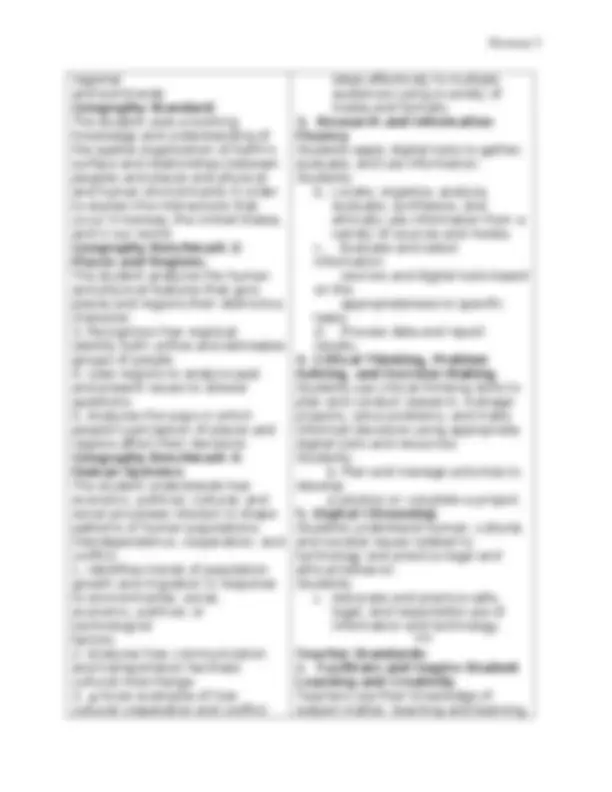
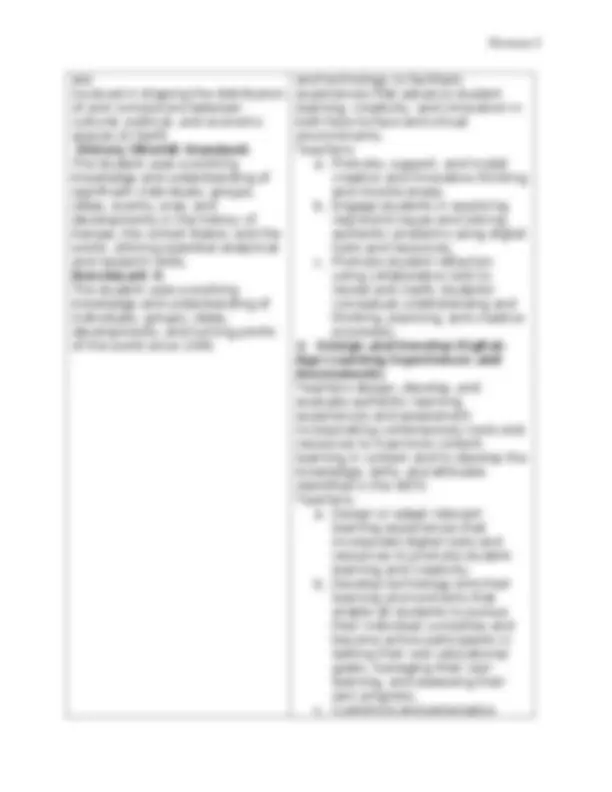
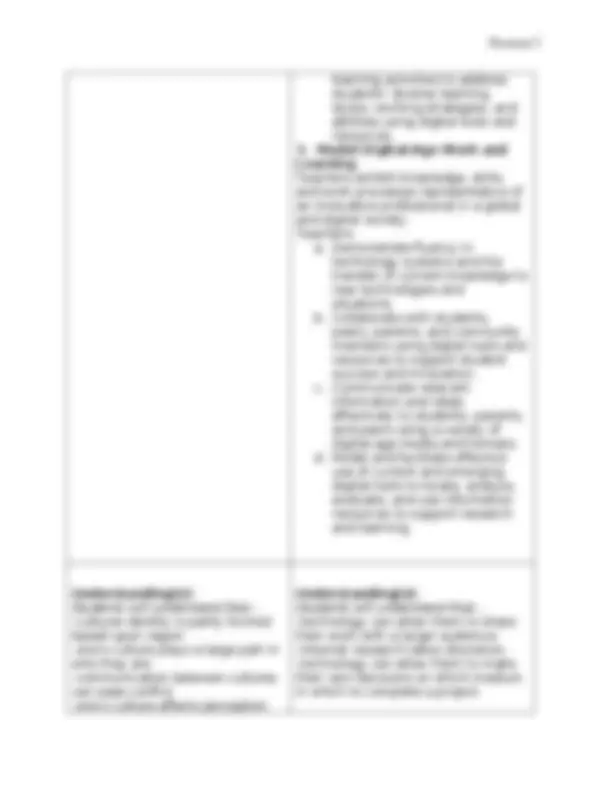
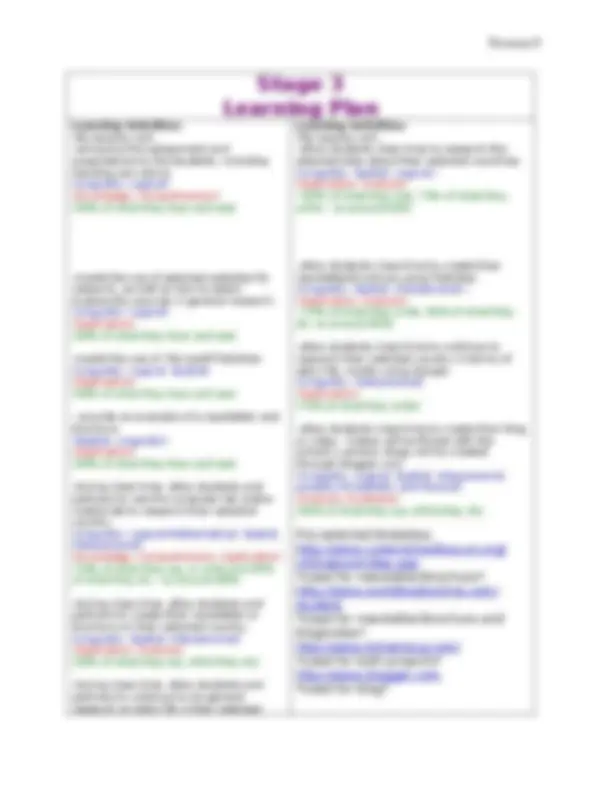
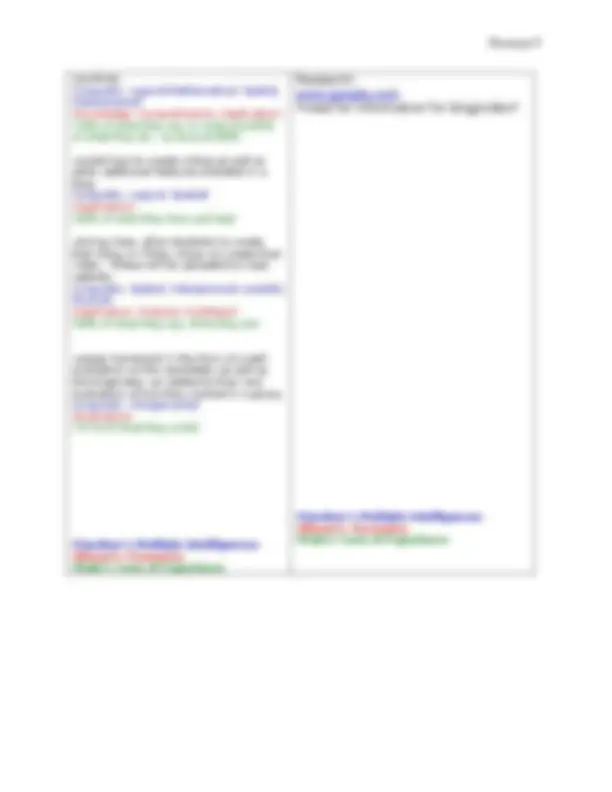
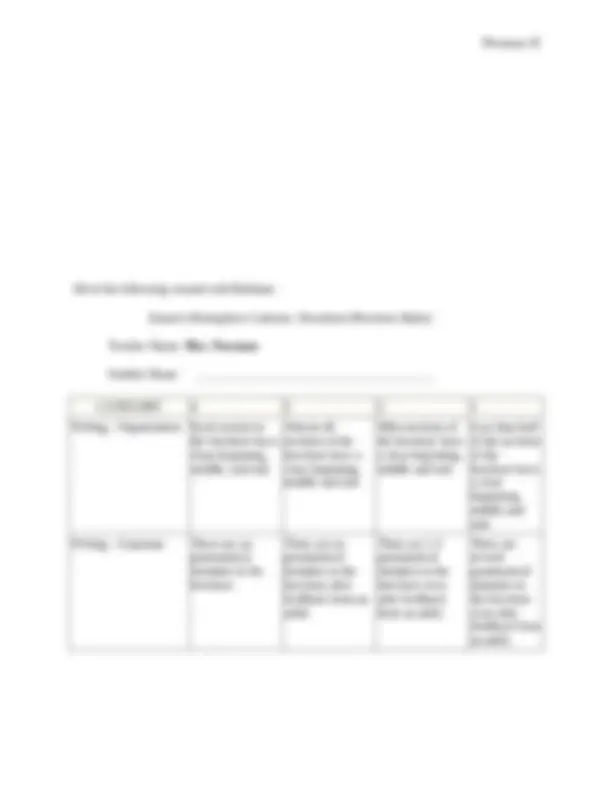
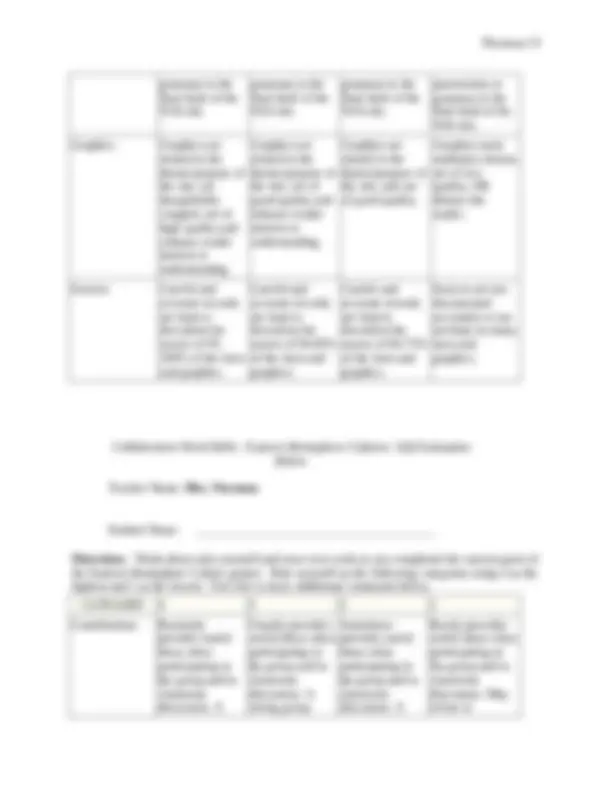
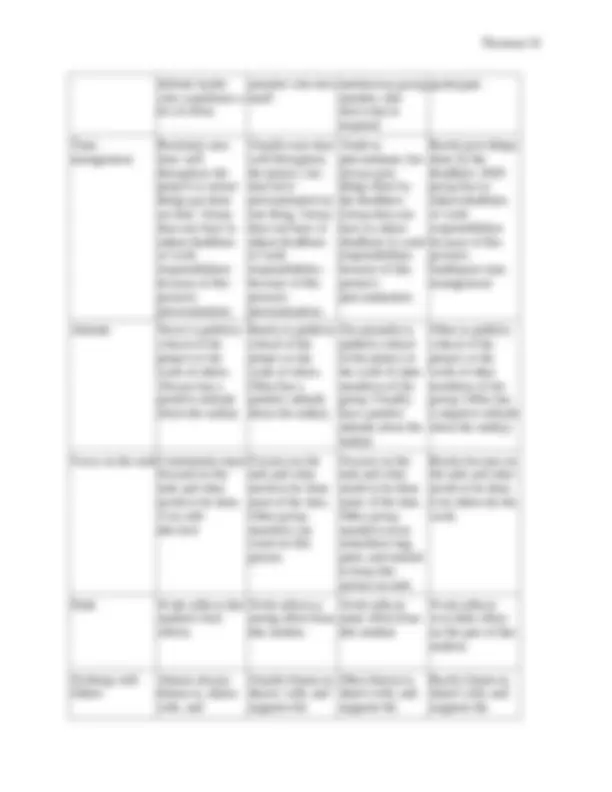
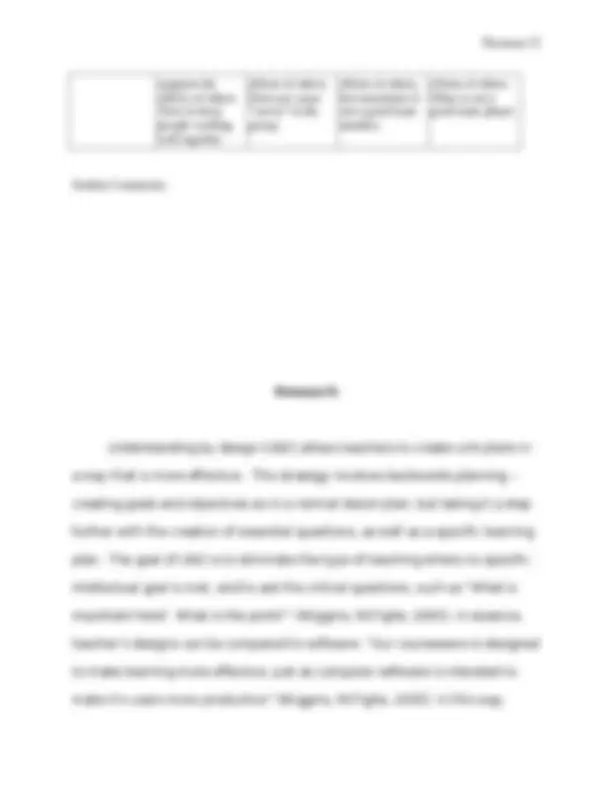
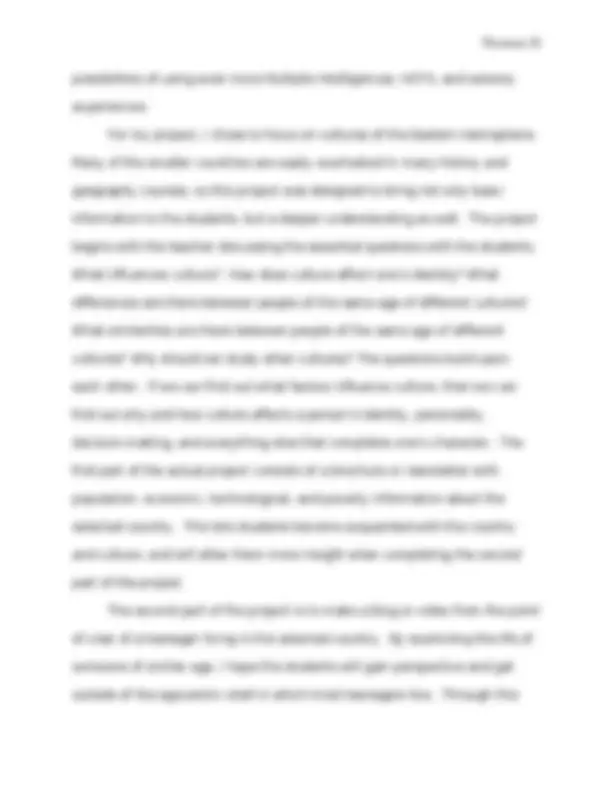
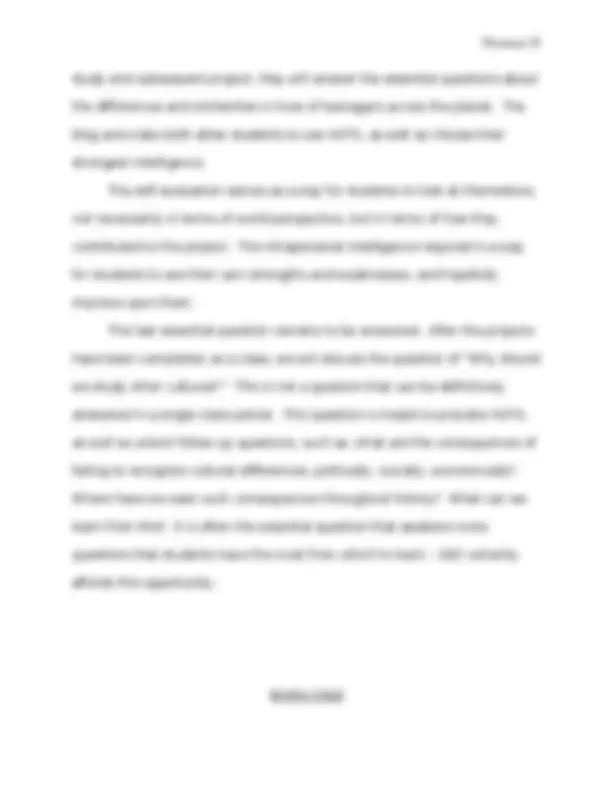
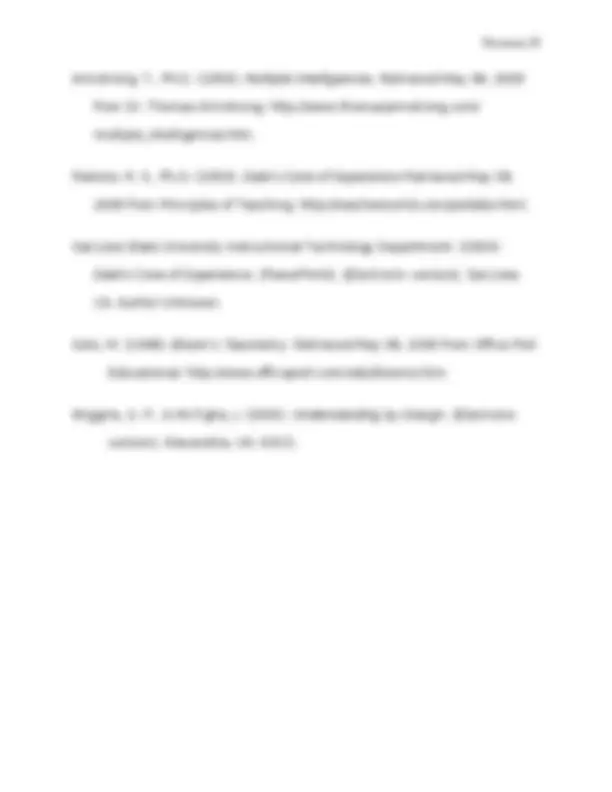


Study with the several resources on Docsity

Earn points by helping other students or get them with a premium plan


Prepare for your exams
Study with the several resources on Docsity

Earn points to download
Earn points by helping other students or get them with a premium plan
Community
Ask the community for help and clear up your study doubts
Discover the best universities in your country according to Docsity users
Free resources
Download our free guides on studying techniques, anxiety management strategies, and thesis advice from Docsity tutors
A project for a university course, edci 718, focused on understanding by design (ubd) in the context of eastern hemisphere cultures. The project involves students researching a selected country, creating a brochure or newsletter, and producing a video or blog. The goal is to develop students' knowledge, skills, and attitudes related to cultural identity, technology use, and research strategies. Students will also engage in essential questions about culture and technology.
Typology: Study Guides, Projects, Research
1 / 20

This page cannot be seen from the preview
Don't miss anything!













Understanding by Design Template Content Technology Stage 1 Desired Results Standards: Civics-Government Standard: The student uses a working knowledge and understanding of governmental systems of Kansas and the United States and other nations with an emphasis on the United States Constitution, the necessity for the rule of law, the civic values of the American people, and the rights, privileges, and responsibilities of becoming active participants in our representative democracy. Civics-Government Benchmark 5: The student understands various systems of governments and how nations and international organizations interact. Indicator:
are involved in shaping the distribution of and connections between cultural, political, and economic spaces on Earth History (World) Standard: The student uses a working knowledge and understanding of significant individuals, groups, ideas, events, eras, and developments in the history of Kansas, the United States, and the world, utilizing essential analytical and research skills. Benchmark 4: The student uses a working knowledge and understanding of individuals, groups, ideas, developments, and turning points of the world since 1945. and technology to facilitate experiences that advance student learning, creativity, and innovation in both face-to-face and virtual environments. Teachers: a. Promote, support, and model creative and innovative thinking and inventiveness. b. Engage students in exploring real-world issues and solving authentic problems using digital tools and resources. c. Promote student reflection using collaborative tolls to reveal and clarify students’ conceptual understanding and thinking, planning, and creative processes.
2. Design and Develop Digital- Age Learning Experiences and Assessments Teachers design, develop, and evaluate authentic learning experiences and assessment incorporating contemporary tools and resources to maximize content learning in context and to develop the knowledge, skills, and attitudes identified in the NETS Teachers: a. Design or adapt relevant learning experiences that incorporate digital tools and resources to promote student learning and creativity. b. Develop technology-enriched learning environments that enable all students to pursue their individual curiosities and become active participants in setting their own educational goals, managing their own learning, and assessing their own progress. c. Customize and personalize
learning activities to address students’ diverse learning styles, working strategies, and abilities using digital tools and resources.
3. Model Digital-Age Work and Learning Teachers exhibit knowledge, skills, and work processes representative of an innovative professional in a global and digital society. Teachers: a. Demonstrate fluency in technology systems and the transfer of current knowledge to new technologies and situations. b. Collaborate with students, peers, parents, and community members using digital tools and resources to support student success and innovation. c. Communicate relevant information and ideas effectively to students, parents, and peers using a variety of digital-age media and formats. d. Model and facilitate effective use of current and emerging digital tools to locate, analyze, evaluate, and use information resources to support research and learning. Understanding(s): Students will understand that… -cultural identity is partly formed based upon region -one’s culture plays a large part in who they are -communication between cultures can ease conflict -one’s culture affects perception Understanding(s): Students will understand that… -technology can allow them to share their work with a larger audience. -Internet research takes discretion. -technology can allow them to make their own decisions on which medium in which to complete a project.
people of the same age of different cultures?
Stage 3 Learning Plan Learning Activities: The teacher will…
- announce the assignment and expectations to the students, including handing out rubrics. (Linguistic, Logical) (Knowledge, Comprehension) (50% of what they hear and see) -model the use of selected websites for research, as well as how to select trustworthy sources in general research. (Linguistic, Logical) (Application) (50% of what they hear and see) -model the use of Microsoft Publisher (Linguistic, Logical, Spatial) (Application) (50% of what they hear and see)
All of the following created with Rubistar: Eastern Hemisphere Cultures: Newsletter/Brochure Rubric Teacher Name: Mrs. Newman Student Name: ________________________________________ CATEGORY 4 3 2 1 Writing - Organization Each section in the brochure has a clear beginning, middle, and end. Almost all sections of the brochure have a clear beginning, middle and end. Most sections of the brochure have a clear beginning, middle and end. Less than half of the sections of the brochure have a clear beginning, middle and end. Writing - Grammar There are no grammatical mistakes in the brochure. There are no grammatical mistakes in the brochure after feedback from an adult. There are 1- grammatical mistakes in the brochure even after feedback from an adult. There are several grammatical mistakes in the brochure even after feedback from an adult.
Content - Accuracy All facts in the brochure are accurate. 99-90% of the facts in the brochure are accurate. 89-80% of the facts in the brochure are accurate. Fewer than 80% of the facts in the brochure are accurate. Graphics/Pictures Graphics go well with the text and there is a good mix of text and graphics. Graphics go well with the text, but there are so many that they distract from the text. Graphics go well with the text, but there are too few and the brochure seems "text- heavy". Graphics do not go with the accompanying text or appear to be randomly chosen. Sources Careful and accurate records are kept to document the source of 95- 100% of the facts and graphics. Careful and accurate records are kept to document the source of 94-85% of the facts and graphics. Careful and accurate records are kept to document the source of 84-75% of the facts and graphics. Sources are not documented accurately or are not kept on many facts and graphics. Eastern Hemisphere Cultures: Video Project Rubric Teacher Name: Mrs. Newman Student Name: ________________________________________ CATEGORY 4 3 2 1 Images Images create a distinct atmosphere or tone that matches different parts of the story. The images may communicate symbolism and/or metaphors. Images create an atmosphere or tone that matches some parts of the story. The images may communicate symbolism and/or metaphors. An attempt was made to use images to create an atmosphere/tone but it needed more work. Image choice is logical. Little or no attempt to use images to create an appropriate atmosphere/tone.
grammar in the final draft of the Web site. grammar in the final draft of the Web site. grammar in the final draft of the Web site. punctuation or grammar in the final draft of the Web site. Graphics Graphics are related to the theme/purpose of the site, are thoughtfully cropped, are of high quality and enhance reader interest or understanding. Graphics are related to the theme/purpose of the site, are of good quality and enhance reader interest or understanding. Graphics are related to the theme/purpose of the site, and are of good quality. Graphics seem randomly chosen, are of low quality, OR distract the reader. Sources Careful and accurate records are kept to document the source of 95- 100% of the facts and graphics. Careful and accurate records are kept to document the source of 94-85% of the facts and graphics. Careful and accurate records are kept to document the source of 84-75% of the facts and graphics. Sources are not documented accurately or are not kept on many facts and graphics. Collaborative Work Skills : Eastern Hemisphere Cultures: Self-Evaluation Rubric Teacher Name: Mrs. Newman Student Name: ________________________________________ Directions : Think about only yourself and your own work as you completed the various parts of the Eastern Hemisphere Culture project. Rate yourself on the following categories using 4 as the highest and 1 as the lowest. Feel free to leave additional comments below. CATEGORY 4 3 2 1 Contributions Routinely provides useful ideas when participating in the group and in classroom discussion. A Usually provides useful ideas when participating in the group and in classroom discussion. A strong group Sometimes provides useful ideas when participating in the group and in classroom discussion. A Rarely provides useful ideas when participating in the group and in classroom discussion. May refuse to
definite leader who contributes a lot of effort. member who tries hard! satisfactory group member who does what is required. participate. Time- management Routinely uses time well throughout the project to ensure things get done on time. Group does not have to adjust deadlines or work responsibilities because of this person's procrastination. Usually uses time well throughout the project, but may have procrastinated on one thing. Group does not have to adjust deadlines or work responsibilities because of this person's procrastination. Tends to procrastinate, but always gets things done by the deadlines. Group does not have to adjust deadlines or work responsibilities because of this person's procrastination. Rarely gets things done by the deadlines AND group has to adjust deadlines or work responsibilities because of this person's inadequate time management. Attitude Never is publicly critical of the project or the work of others. Always has a positive attitude about the task(s). Rarely is publicly critical of the project or the work of others. Often has a positive attitude about the task(s). Occasionally is publicly critical of the project or the work of other members of the group. Usually has a positive attitude about the task(s). Often is publicly critical of the project or the work of other members of the group. Often has a negative attitude about the task(s). Focus on the task Consistently stays focused on the task and what needs to be done. Very self- directed. Focuses on the task and what needs to be done most of the time. Other group members can count on this person. Focuses on the task and what needs to be done some of the time. Other group members must sometimes nag, prod, and remind to keep this person on-task. Rarely focuses on the task and what needs to be done. Lets others do the work. Pride Work reflects this student's best efforts. Work reflects a strong effort from this student. Work reflects some effort from this student. Work reflects very little effort on the part of this student. Working with Others Almost always listens to, shares with, and Usually listens to, shares, with, and supports the Often listens to, shares with, and supports the Rarely listens to, shares with, and supports the
teachers look to ensure that learners are in fact, learning not simply rote, but meaningful information; but most of all, understanding the content on a deeper level. UbD is not necessarily a new type of teaching strategy, but a new way of planning, to help ensure success (Wiggins, McTighe, 2005). UbD strives to eliminate what has become in many schools, teaching to the test so that students will pass state assessments. While high test scores do look good, they do not ensure deeper learning and understanding. UbD allows teachers to incorporate new ideas with new technologies in a manner that will promote more meaningful learning. When teachers incorporate other strategies such as Howard Gardner’s Multiple Intelligences, Bloom’s Taxonomy, and Dale’s Cone of Understanding, the subsequent results can be even greater. Gardner argues that people are neither intelligent nor unintelligent; they just differ in how they are intelligent (Armstrong, 2000). Gardner identifies eight different types of intelligences. These include linguistic, logical-mathematical, spatial, musical, intrapersonal, interpersonal, bodily- kinesthetic, and naturalist intelligences. He goes on to assert that teachers should recognize this fact, and modify how they teach. In the United States, teachers tend to rely on methods that are most directed at linguistic and logical-mathematical learners. Varying teaching strategies allows more than just one or two types of learners to engage and understand (Armstrong, 2000). With regard to UbD, Multiple Intelligences and UbD complement each
other very well, as Multiple Intelligences are another step in planning, and supplement the UbD approach of reaching more learners and making the learning experience more meaningful. Bloom’s Taxonomy plays a large part in UbD because of its design for more significant learning. Bloom’s Taxonomy is a resource for teachers to use to ensure that they are allowing students to think with Higher Order Thinking Skills (HOTS). Bloom’s research showed that ninety-five percent of test questions, required students to use the lowest level of cognition (Soto, 1998). His aim was to educate teachers on how to provoke deeper thinking and deeper understanding. This fits well in UbD, because the essential questions require Higher Order Thinking Skills. In the same line of thought as Gardner and Bloom, is Edgar Dale’s Cone of Experience. Cone’s research showed that people learn more when they are actually participating in an activity, as opposed to sitting and listening to a lecture or reading a textbook (Pastore, 2003). The use of more senses when participating in an activity will allow for greater retention of content. For example, a real-world experience allows students to see, hear, smell, touch, and possibly taste. Basically, “the more sensory channels possible in interacting with a resource, the better the chance that many students can learn from it” (San Jose Instructional Technology Department, 2004). UbD with the addition of Dale’s Cone allows teachers to plan to make the most of the UbD experience by incorporating multiple senses into the project design. The inclusion of technology with UbD expands the
study and subsequent project, they will answer the essential questions about the differences and similarities in lives of teenagers across the planet. The blog and video both allow students to use HOTS, as well as choose their strongest intelligence. The self-evaluation serves as a way for students to look at themselves, not necessarily in terms of world perspective, but in terms of how they contributed to the project. The intrapersonal intelligence required is a way for students to see their own strengths and weaknesses, and hopefully improve upon them. The last essential question remains to be answered. After the projects have been completed, as a class, we will discuss the question of “Why should we study other cultures?” This is not a question that can be definitively answered in a single class period. This question is meant to provoke HOTS, as well as unlock follow-up questions, such as, what are the consequences of failing to recognize cultural differences, politically, socially, economically? Where have we seen such consequences throughout history? What can we learn from this? It is often the essential question that awakens more questions that students have the most from which to learn. UbD certainly affords this opportunity. Works Cited
Armstrong, T., Ph.D. (2000). Multiple Intelligences. Retrieved May 08, 2009 from Dr. Thomas Armstrong: http://www.thomasarmstrong.com/ multiple_intelligences.htm. Pastore, R. S., Ph.D. (2003). Dale's Cone of Experience Retrieved May 08, 2009 from Principles of Teaching: http://teacherworld.com/potdale.html. San Jose State University Instructional Technology Department. (2004). Dale's Cone of Experience. [PowerPoint]. [Electronic version]. San Jose, CA: Author Unknown. Soto, M. (1998). Bloom's Taxonomy. Retrieved May 08, 2009 from Office Port Educational: http://www.officeport.com/edu/blooms.htm. Wiggins, G. P., & McTighe, J. (2005). Understanding by Design. [Electronic version]. Alexandria, VA: ASCD.